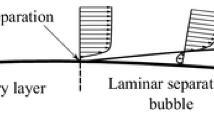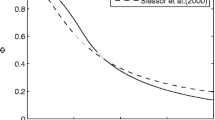Abstract
Direct numerical simulations of separating flow along a section at midspan of a low-pressure V103 compressor cascade with periodically incoming wakes were performed. By varying the strength of the wake, its influence on both boundary layer separation and bypass transition were examined. Due to the presence of small-scale three-dimensional fluctuations in the wakes, the flow along the pressure surface undergoes bypass transition. Only in the weak-wake case, the boundary layer reaches a nearly-separated state between impinging wakes. In all simulations, the flow along the suction surface was found to separate. In the simulation with the strong wakes, separation is intermittently suppressed as the periodically passing wakes managed to trigger turbulent spots upstream of the location of separation. As these turbulent spots convect downstream, they locally suppress separation.
Similar content being viewed by others
References
Breuer, M., Rodi, W.: Large eddy simulation for complex flow of practical interest. In: Hirschel, E.H. (ed.): Flow simulation with high-performance computers II, Notes on Numerical Fluid Mechanics, vol. 52. Vieweg Verlag, Braunschweig (1996)
Cho, N.H., Liu, X., Rodi, W.: Calculation of wake-induced unsteady flow in a turbine cascade. ASME Paper 92-GT-306 (1992)
Coull, J., Hodson, H.: Unsteady boundary-layer transition in low-pressure turbines. J. Fluid Mech. 681, 370–410 (2011)
Durbin, P.A., Wu, X.: Transition beneath vortical disturbances. Ann. Rev. Fluid Mech. 39, 107–128 (2007)
Hack, M.J.P., Zaki, T.A.: Streak instabilities in boundary layers beneath free-stream turbulence. J. Fluid Mech. 741, 280–315 (2014)
Hilgenfeld, L., Pfitzner, M.: Unsteady boundary layer development due to wake-passing effects on a highly loaded linear compressor cascade. J. Turbomach. 126, 493–500 (2004)
Jacobs, R.G., Durbin, P.A.: Simulations of bypass transition. J. Fluid Mech. 428, 185–212 (2001)
Kalitzin, G., Wu, X., Durbin, P.: DNS of fully turbulent flow in a LPT passage. Int. J. Heat Fluid Flow 24, 636–644 (2003)
Mayle, R.E.: The role of laminar-turbulent transition in gas turbine engines. ASME Paper 91-GT-261 (1991)
Michelassi, V., Martelli, F., Dénos, T., Arts, T., Sieverding, C.: Unsteady heat transfer in stator-rotor interaction by two-equation turbulence model. ASME. J. Turbomach. 121, 436–447 (1999)
Nagarajan, S., Lele, S., Ferziger, J.: Leading edge effects in bypass transition. J. Fluid Mech. (2007)
Nolan, K.P., Zaki, T.A.: Conditional sampling of transitional boundary layers in pressure gradients. J. Fluid Mech. 728, 306–339 (2013)
Rhie, C., Chow, W.: Numerical study of the turbulent flow past an airfoil with trailing edge separation. AIAA. J. 21(11), 1525–1532 (1983)
Stadtmüller, P., Fottner, L.: A test case for the numerical investigation of wake-passing effects of a highly-loaded lp turbine cascade blade. ASME paper 2001-GT-311 (2001)
Stieger, R., Hodson, H.: Convection of a turbulent bar wake through a low-pressure turbine cascade. ASME J. Turbomach. 127, 388–394 (2005)
Stone, H.: Iterative solutions of implicit approximations of multidimensional partial differential equations. SIAM J. Nunerical Anal. 5, 87–113 (1968)
Vaughan, N.J., Zaki, T.A.: Stability of zero-pressure-gradient boundary layer distorted by unsteady klebanoff streaks. J. Fluid Mech. 681, 116–153 (2011)
Wissink, J.: DNS of separating low Reynolds number flow in a turbine cascade with incoming wakes. Int. J. Heat Fluid Flow 24, 626–635 (2003)
Wissink, J., Rodi, W.: Numerical study of the near wake of a circular cylinder. Int. J. Heat Fluid Flow 29, 1060–1070 (2008)
Wissink, J., Rodi,W., Hodson, H.: The influence of disturbances carried by periodically incoming wakes on the separating flow around a turbine blade. Int. J. Heat Fluid Flow 27, 721–729 (2006)
Wu, X., Durbin, P.A.: Existence of longitudinal vortices evolved from distorted wakes in a turbine passage. J. Fluid Mech. 446, 199–228 (2001)
Zaki, T., Wissink, J., Durbin, P., Rodi, W.: Direct numerical simulations of transition in a compressor cascade: the influence of free-stream turbulence. J. Fluid Mech. 665, 57–98 (2010)
Zaki, T.A.: From streaks to spots and on to turbulence: Exploring the dynamics of boundary layer transition. Flow, Turbul. Combust. 91, 451–473 (2013)
Zaki, T.A., Durbin, P.A.:Mode interaction and the bypass route to transition. J. FluidMech. 531, 85–111 (2005)
Zaki, T.A., Durbin, P.A.: Continuous mode transition and the effects of pressure gradient. J. FluidMech. 563, 357–388 (2006)
Zaki, T.A., Saha, S.: On shear sheltering and the structure of vortical modes in single- and two-fluid boundary layers. J. Fluid Mech. 626, 111–147 (2009)
Zaki, T.A., Wissink, J.G., Durbin, P.A., Rodi, W.: Direct computations of boundary layers distorted by migrating wakes in a linear compressor cascade. Flow, Turbul. Combust. 83(3), 307–322 (2009)
Author information
Authors and Affiliations
Corresponding author
Rights and permissions
About this article
Cite this article
Wissink, J.G., Zaki, T.A., Rodi, W. et al. The Effect of wake Turbulence Intensity on Transition in a Compressor Cascade. Flow Turbulence Combust 93, 555–576 (2014). https://doi.org/10.1007/s10494-014-9559-z
Received:
Accepted:
Published:
Issue Date:
DOI: https://doi.org/10.1007/s10494-014-9559-z




